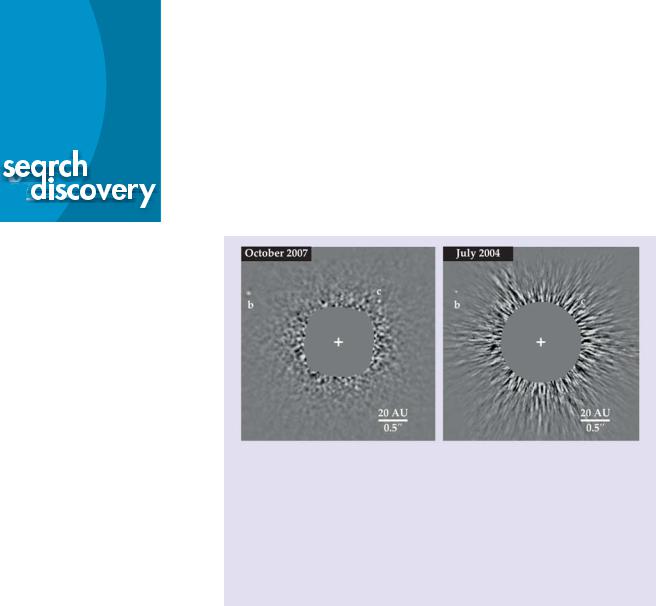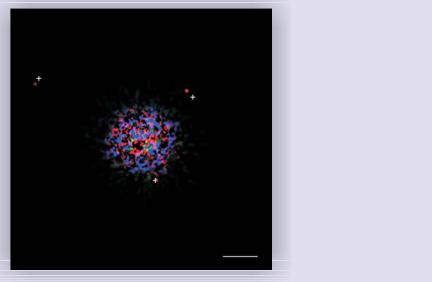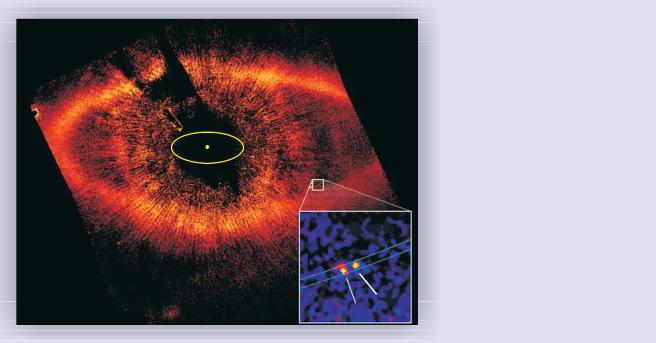
- •LETTERS
- •Cocktail party at the beginning of the universe
- •Domingo de Soto, early dynamics theorist
- •Making partners of universities and corporations
- •Correcting the record of manmade VLF radiation
- •Direct imaging reveals exoplanets in orbital motion
- •Pressure unites two regimes of fluid breakup
- •Nuclear weapons at a crossroads as Obama enters office
- •Applying Title IX to university science departments
- •DOE invites partners in green technology
- •LBNL director Chu to head DOE
- •NASA sells technology rights to highest bidder
- •Scientists entertain Hollywood queries
- •Europe sets astronomy path
- •US, China settle on nuclear terms
- •Solving quantum field theories via curved spacetimes
- •Panofsky agonistes: The 1950 loyalty oath at Berkeley
- •OPINION
- •BOOKS
- •William and Lawrence Bragg, Father and Son
- •Energy in Nature and Society
- •The Bethe–Peierls Correspondence
- •NEW PRODUCTS
- •OBITUARIES
- •Theodore Eugene Madey
- •Julius Erich Wess
- •The versatility of nanoscale mechanical resonators
- •Biomimetic ceramics

Nanotube logic
A publication of the American Institute of Physics

letters
Imaging technologies need trained practitioners
I was dismayed by the statement attributed to Angela Gronenborn in David Kramer’s piece (PHYSICS TODAY, February 2008, page 27) that nuclear magnetic resonance (NMR) “technology is less mature than x-ray crystallography, which has evolved to the point where it is considered ‘black box,’ meaning experimenters don’t need to be conversant in the technology to use it.” I agree that it has become substantially easier to collect x-ray diffraction images, analyze them, use that information to solve the phase problem, view electron density, and build a crystal structure. However, I strongly disagree that the devices, algorithms, or field is so complicated as to be hidden or mysterious—a so-called black box— to the user or that a user doesn’t need to be conversant with the technology to use it.
Do we really want scientists in any field to use software, instrumentation, and technologies that they don’t understand? Are we training undergraduates, graduate students, and postdoctoral research fellows adequately, or at a minimal level to produce a noncritical set of data? At a time when scientific research and technology are changing so rapidly, and are more accessible, don’t we wish to encourage researchers to understand as much as they can? That is the correct paradigm.
I appreciate the fact that it’s easier to include crystallography as a central in-
Letters and opinions are encouraged and should be sent by e-mail to ptletters@aip.org (using your surname as “Subject”), or by standard mail to Letters, PHYSICS TODAY, American Center for Physics, One Physics Ellipse, College Park, MD 20740-3842. Please include your name, affiliation, mailing address, e-mail address, and daytime phone number on your attachment or letter. You can also contact us online at http://www.physicstoday.org/pt/ contactus.jsp. We reserve the right to edit submissions.
vestigative tool in all major fields of scientific research. However, that also means that it’s easier to collect data incorrectly due to overlaps, overexposure, poor sample quality, or incompleteness, or to process it rapidly and incorrectly as with poor indexing, wrong unit cell, wrong space group, or twinning, and still arrive at some sort of electron density and resultant structure. Anyone using crystallography needs to be critical at each step. Several recent retractions of protein structures published in high-profile journals attest to the increased lack of critical analysis. We should not confuse ease with transparency and ignorance with rigor for any technology. A major fault with our present educational hegemony is that the fundamentals of crystallography are no longer adequately presented in science courses. Crystallography, like NMR, is an incredibly powerful tool and continues to develop and thrive on the challenge of investigating larger, more dynamic, and more complex biological and chemical systems. It is liberated and expansive because of its maturity.
B. D. Santarsiero
(bds@uic.edu) University of Illinois at Chicago
Gronenborn replies: My comment comparing nuclear magnetic resonance and x-ray crystallography as structural techniques was intended to highlight the younger nature of NMR versus crystallography. Crystallographers and NMR spectroscopists worth their salt would never advocate blind use of technologies without a thorough understanding of their basic principles, strengths, and limitations. Problems arising from loose interpretation and misuse of technology without critical analysis of the origin, quality, and reproducibility of generated data are, unfortunately, too common. But not every scientist is a methods developer or is, as David Kramer puts it in his report, well “conversant in the technology.” Success in the complex structural-biology tasks that lie ahead can be ensured only through rigorous education and train-
ing of students to critically and carefully use all methodologies available.
Angela M. Gronenborn
(amg100@pitt.edu) University of Pittsburgh Pittsburgh, Pennsylvania
Cocktail party at the beginning of the universe
I’ve just finished reading the feature article by Daniel Eisenstein and Charles Bennett about cosmic sound waves (PHYSICS TODAY, April 2008, page 44). As an acoustical engineer, I am especially drawn to the 1 part in 105 smoothness of the cosmic microwave background (CMB) fluctuations and the attendant “sound wave” analogy. I’m wondering whether your readers appreciate the elegance of this analogy.
Although 1/100 000 may at first seem tiny, acousticians deal in such ratios daily. Consider that an atmospheric pressure fluctuation of 1 bar, expressed in decibels, is approximately 194 dB, while a typical sound level measured in a crowded room of moderate size full of loudly talking people might easily approach 80 dB, a pressure ratio well below 10–5. Thus lively conversation superimposed on atmospheric pressure looks exactly like the Wilkinson Microwave Anisotropy Probe’s CMB anisotropy. So a proper analogy for the CMB fluctuations might be the cocktail party at the beginning of the universe. Acoustically, one part in 105 smoothness is not a terribly small variation but rather should be regarded as quite normal. We should expect to be able, in a sense, to extract portions of the intelligible conversation from among the din. CMB analysts are working with what would be analogous to a snapshot of an instant in that cocktail party conversation rather than having to wrestle, as acousticians must, with a fully dynamic situation. In Eisenstein and Bennett’s figure 2, the three peaks in the power spectral density function at 0.6°, 0.4°, and 0.2° reveal hints of that conversa-
8 January 2009 Physics Today
© 2009 American Institute of Physics, S-0031-9228-0901-220-4

tion. It is interesting to consider where this line of thought might lead.
Robert A. Putnam
(bob.putnam@siemens.com) Siemens Energy Inc Orlando, Florida
Domingo de Soto, early dynamics theorist
The public recognition that innovative scientists receive is nowadays regarded as a fundamental incentive to scientific research. Before Galileo, when scientists were mostly members of the religious orders that controlled medieval universities, acknowledging prior work was not considered so important. For that and other reasons the authors of many significant scientific contributions receded into an obscurity from which only modern scholarship has rescued them. Edith Sylla’s interesting article about Thomas Bradwardine’s influence on the development of dynamics (PHYSICS TODAY, April 2008, page 51) prompts me to draw attention to what may have been a key original contribution. Spanish Dominican friar Domingo de Soto (1494–1560) clearly stated that a freely falling body undergoes uniform acceleration (motus uniformiter difformis): “For when a heavy object falls through a homogeneous medium from a height, it moves with greater velocity at the end than at the beginning. . . . And what is more, the [motion] . . . increases uniformly difformly.”1
There is no evidence, and it is unlikely, that de Soto’s assertion was based on experiment; it was an intuition that must have been suggested by experience, of course, but without any attempt to control that experience so as to extract from it the desired information. In fact, the immediate context of his assertion is not a discussion of the physics of falling bodies but a classification of types of motion; that heavy bodies fall with uniform acceleration is mentioned to illustrate the notion of uniform acceleration, and perhaps only secondarily as a natural-world example of that abstract concept. Be that as it may, the example remained in the literature for scholars of that time to consider (eight editions of de Soto’s Quaestiones super octo libros physicorum Aristotelis were published between 1551 and 1613), and it is likely to have been known to Galileo, who mentions de Soto in his
Tractatus de Elementis and who attended classes by some of de Soto’s intellectual
descendants2 at the Roman College (now the Pontifical Gregorian University) in Rome.
Furthermore, it was accompanied by an explicit indication that because of the uniformly accelerated nature of its motion, the distance traveled by a freely falling body can be calculated using the mean velocity theorem that had been stated and proved in the 14th century by the Oxford Calculators: for in seeking an appropriate global measure of the velocity of a uniformly accelerating object such as a falling heavy body, de Soto notes that “if the moving object A keeps increasing its velocity from 0 to 8, it covers just as much space as [another object] B moving with a uniform velocity of 4 in the same period of time.”1 He was thus the first to apply mathematics successfully to this physical problem— without experimental verification, but in a way that, because it was mathematically precise and physical, constituted an exceptionally clear invitation to experimental verification for such inquisitive minds as were prepared to recognize it.
If de Soto’s writings did influence Galileo, as seems quite probable, they may have influenced his thinking on dynamics as well as on kinematics. According to Juan José Pérez Camacho and Ignacio Sols Lucía, de Soto’s concept of the resistentia interna of a body foreshadows Galileo’s resistenza interna in being intrinsic to the body itself rather than to its medium, and proportional to the weight of the body.3 What is less tenable is Pérez Camacho and Sols Lucía’s thesis that de Soto considered the velocity v of a moving body to be proportional to the motive force f and inversely proportional to its resistentia interna r—which would be correct in the case of a body accelerated from rest by a constant force, with time as the constant of proportionality and inertial mass as resistentia interna. On the contrary, it seems clear that de Soto’s understanding of the relationship among these quantities corresponded not to the formula v f/r but rather to the formula v log(f/r), first proposed by Bradwardine.4 The road from Aristotle to Galileo was long and tortuous, and those who advanced in one dimension often remained stationary or receded in others; de Soto’s contribution, though modest, may have been vital.
References
1.D. de Soto, cited in translation in W. A. Wallace, Isis 59, 384 (1968), p. 400.
2.W. A. Wallace, Domingo de Soto and the Early Galileo: Essays on Intellectual History, Ashgate, Aldershot, UK, and Burlington, VT (2004).
FEMTO® Messtechnik GmbH Berlin / Germany
info@femto.de ν www.femto.de
www.physicstoday.org |
January 2009 Physics Today 9 |

The Easiest Way to Find Angular Position?
TILTMETERS
Track angular movement and structural deformation in:
•Particle accelerators
•Beamlines • Antennae
•Aircraft • Fixtures & machinery
With sensitivities to 5 nanoradians, we offer your best choices for precision tilt measurement.
415.364.3200 USA WWW.GEOMECHANICS.COM
3.J. J. Pérez Camacho, I. Sols Lucía, Rev. Filos. 7(12), 455 (1994), p. 471, available at http://www.ucm.es/BUCM/revistas/fsl/ 00348244/articulos/RESF9494220455A
.PDF.
4.W. A. Wallace, in Texts and Contexts in Ancient and Medieval Science, E. Sylla, M. McVaugh, eds., Brill, Leiden, the Netherlands (1997), p. 286.
Jorge Mira-Pérez
(jorge.mira@usc.es) University of Santiago de Compostela Santiago de Compostela, Spain
Making partners of universities and corporations
I commend PHYSICS TODAY for its publication of the story “Universities and Industry Find Roadblocks to R&D Partnering” (PHYSICS TODAY, May 2008, page 20). The author indicates a number of sore spots in university–industry partnerships, especially the negotiation of intellectual property rights in research agreements. The University– Industry Demonstration Partnership, of which I am a past president, has been doing important work in providing a neutral forum, under the auspices of the National Academies, for open and frank discussions between companies and universities about their differences and their commonalities. Issues for discussion include contract negotiations, IP rights in collaborative research, the Bayh–Dole Act, competition from overseas research organizations, Internal Revenue Service policies on the use of buildings financed through tax-exempt bonds, and open source collaborations. The UIDP is interested in improving and streamlining connections between companies and universities for their mutual benefit, the betterment of society, and the country’s economic security.
The UIDP strives to remain objective and politically neutral. It fosters the free and open expression of frustrations so they do not silently eat away at mutual trust. The partnership encourages the parties to seek common ground and a shared vision and, when that doesn’t work, to look for adequate compromise.
Currently the UIDP has 94 members, one-third of them from industry. Our industrial membership is quite evenly spread over health and life sciences, chemicals and materials, information technology, and consumer products manufacturing. Our university membership is also a mix of land grant colleges and universities, state and other public institutions of higher education,
10 January 2009 Physics Today
and private institutions.
The UIDP hopes to continue its work and to connect even more companies and academic institutions.
Robert Killoren
(killoren.2@osu.edu) Ohio State University Columbus
Correcting the record of manmade VLF radiation
The story by Charles Day (PHYSICS TODAY, August 2008, page 18) on the effects of very low-frequency radio waves on trapped electrons in the radiation belts describes interesting results obtained on the interaction of manmade VLF radiation with radiationbelt particles.1
Unfortunately, the PHYSICS TODAY piece contains several errors.
The absence of radiation in a region of the North Atlantic Ocean is depicted in figure 3 of Day’s story—conjugate to the region of radiation detected by the instruments of Jean-André Sauvaud and coworkers1 at 700 km in the South Atlantic Anomaly. That absence is not because of the loss of that radiation by precipitation into the atmosphere but because the northern particle mirror points conjugate to the South Atlantic Anomaly radiation lie at altitudes well above the altitude of the satellite carrying the instruments of Sauvaud’s team.
In the South Atlantic in late August and early September 1958, there were three nuclear tests, not one as the author states.
The first artificial aurora created by a nuclear test was the result of the Teak test in early August 1958, albeit at low latitudes near the Pacific test site of Johnson Island.
The treaty prohibiting tests in the atmosphere, in space, and under water had a far more complex ancestry than just the results and effects of Starfish Prime, as stated by the author. Widespread concerns regarding the biological effects of fallout and the desire to tamp down the arms race were the major factors that led to the limited test ban treaty of 1963.
Reference
1.J.-A. Sauvaud, R. Maggiolo, C. Jacquey, M. Parrot, J.-J. Berthelier, R. J. Gamble, C. J. Rodger, Geophys. Res. Lett. 35, L09101 (2008), doi:10.1029/2008GL033194.
George Paulikas
(george.a.paulikas@aero.org) El Segundo, California
www.physicstoday.org

Direct imaging reveals exoplanets in orbital motion
If a planet orbiting another star is young enough, the afterglow from its heat of formation may be adequate for imaging.
Most of the more than 300 exoplanets found thus far have been detected by the periodic Doppler shifting of the host star’s spectrum as an orbiting planet tugs it to and fro. A few have revealed themselves by periodically dimming a star’s perceived brightness as they transit across its face. And gravitational microlensing has uncovered a handful (see PHYSICS TODAY, April 2006, page 22). But none of those techniques is practical for planets that orbit their stars at distances larger than about 5 astronomical units. (1 AU is the mean distance between Earth and the Sun.)
There is, however, a search technique that gets easier with increasing distance between star and planet— namely, direct imaging. A planet less than about 10 AU (the orbital radius of Saturn) from its star is lost in the star’s glare. And beyond 10 AU, reflected starlight would generally be too dim for imaging. But young Jovian planets less than a few hundred million years old are expected to retain enough of their heat of formation to glow quite brightly in the IR. That glow not only makes imaging feasible; its photometric and spectral details also promise to reveal much about a planet’s makeup.
Therefore astronomers have in recent years been imaging the environs of nearby young stars at near-IR wavelengths in search of planets. The task is made difficult by the enormous brightness contrast between a star and a warm planet separated by only about an arcsecond. But now in back-to-back papers, two groups have reported the imaging of Jovian planets orbiting stars in our local neighborhood.1,2 Both groups, having recorded images several years apart, present evidence that the planet candidates are indeed gravitationally bound objects in Keplerian orbits.
A three-planet system
Availing themselves of the adaptiveoptics systems of two of the world’s largest telescopes, atop Hawaii’s Mauna Kea, a group led by Christian Marois of
Figure 1. The two outermost planets (labeled b and c) of the three found orbiting the young star HR 8799 at distances from 24 to 68 astronomical units (AU) were discovered in adaptive-optics IR images taken with the 8-m Gemini telescope in October 2007. (1 AU is the mean distance between Earth and Sun.) The obscuring glare of the star, whose position is marked by the cross, was suppressed by a technique called angular differential imaging (ADI); here the residual glare has been entirely erased from the central region. After the discovery, the two planets were found again, at slightly rotated positions, in a reanalysis of near-IR images that had been taken, without benefit of ADI, at the 10-m Keck II telescope in July 2004. (Adapted from ref. 1.)
Canada’s Herzberg Institute of Astrophysics has produced images over a range of near-IR wavelengths of three planets orbiting a luminous young star, HR 8799, about 130 light-years from our solar system.1
From the counterclockwise displacements of the planet images from July 2004 to September 2008, the group concludes that it is seeing almost circular orbits roughly face-on, with orbital radii of about 24, 38, and 68 AU (see figures 1 and 2). At those radii, the observed displacements of the three planets over four years are consistent with Keplerian revolution around the star, whose mass is known to be about 1.5 solar masses M .
HR 8799 is an A-type star, hotter and about five times more luminous than the G-type Sun. That exacerbates the problem of brightness contrast. But IR planet searches of several hundred nearby young stars no more luminous
than the Sun had found nothing. “So we had to start looking at A stars,” says Marois. “And this is what we found after looking at just a handful.” The obvious conclusion is that at separations larger than 20 AU, Jovian planets are far more common around young A stars than around smaller, cooler sun-like stars of the same age.
The outermost two planets of the system were discovered in IR images taken at the 8-meter Gemini telescope on Mauna Kea in October 2007 (left panel of figure 1). The blurring due to atmospheric turbulence was dealt with by an adaptive-optics system that continually adjusted the shape of a small mirror in response to observed distortion of the central star’s image. But then the star’s image, broadened by diffraction, had to be minimized to render planets visible. To that end, Marois and company used a trick called angular differential imaging (ADI). Keeping the
© 2009 American Institute of Physics, S-0031-9228-0901-320-9
January 2009 Physics Today 11

telescope centered on the star, they allowed the camera’s field of view to rotate around the star with the telescope’s changing orientation during the night. Then they minimized nonplanetary features by subtracting from repeated exposures those features that didn’t rotate with the field of view: the star itself, diffraction artifacts related to structural elements of the telescope, and speckles due to imperfections in the primary mirror or other optical components.
Having discovered the two planets at the Gemini telescope, the group found them also in a reanalysis of IR pictures they had taken of the same star in 2004 with the Keck II 10-meter telescope up the road (right panel of figure 1). The group found the innermost of the three planets with Keck II in July 2008. Figure 2 shows the most sensitive ADI image of the system, acquired two months later at Keck II in three near-IR bands. To indicate how well ADI reduces the star’s obscuring image, the residual stellar image is left unscrubbed in the figure.
Weighing the planets
Unlike the Doppler method, which straightforwardly yields a lower mass limit for the discovered planet, direct imaging has to rely on cooling models and estimates of the planet’s age and temperature to determine its mass with only modest precision. And that can become an issue of contention: A mass threshold of 13.6 MJ (Jupiter masses) separates large gas planets from brown dwarfs—semistellar bodies massive enough to support deuterium fusion but not the hydrogen fusion that marks a true star (see PHYSICS TODAY, June 2008, page 70).
Imaging a brown dwarf is regarded as less of an accomplishment than imaging a true exoplanet. Given its size and internal heat source, a brown dwarf is likely to glow more brightly in the IR than a planet, and it generally sits further from any stellar companion. Indeed several brown dwarfs have in recent years been imaged in orbit around stars. But it’s not clear how instructive such pairings are about the formation of actual planetary systems.
From the luminosities of the planet candidates at wavelengths from 1 to 4 μm, the group’s best mass estimates are 7 MJ for the outermost planet and 10 MJ for the other two. “But,” cautions planet hunter Goeffrey Marcy (University of California, Berkeley), “those masses depend sensitively on the host star’s assumed age.” The older the planet, the greater is its mass for a given
12 January 2009 Physics Today
|
September 2008 |
|
b |
July 2004 |
|
c |
||
|
July 2004
July 2008 d
0.5″ 20 AU
Figure 2. HR 8799’s third planet (labeled d), only 24 AU from the star, was revealed in follow-up observations with the Keck II telescope in July 2008. In this composite image, which superposes observations at various near-IR wavelengths (shown in false colors) with Keck II in September 2008, the residual stellar glare that survives the angular differential imaging has not been erased. The dated crosses indicate how each planet has moved since it was first imaged. All three displacements are consistent with circular Keplerian orbits seen face-on. (Adapted from ref. 1.)
present temperature. That’s primarily because more heat is generated in the formation of heavier bodies.
So an upper age limit corresponds to an upper mass limit. From HR 8799’s color, luminosity, unusually massive debris disk, and stellar associates in its galactic neighborhood, Marois and company estimate the star’s age to be about 60 Myr, with a very conservative upper limit of 160 Myr. Comparably conservative models of planetary cooling then yield upper limits of 13 MJ for the two heavier planets—just below the threshold for brown dwarfs. ”Besides,” says Marois, “these are three objects revolving in the same direction in essentially coplanar orbits around a star. No one has ever seen two or more brown dwarfs in such a system.”
The system looks something like a scaled-up version of our own outermost planets girdled by a belt of dust and debris like our Kuiper belt. Planet formation can depend on the local intensity of stellar heating. For example, the radius of the so-called snow line— beyond which ice can accumulate on rocky material to form a growing core that might eventually accrete a giant envelope of gas—scales like the square root of the star’s luminosity. Thus scaled down to the Sun’s luminosity, the temperature equivalents of the three HR 8799 orbital radii are 11, 17, and 31 AU, much like the 10, 19, and 30 AU orbits of Saturn, Uranus, and Neptune.
But temperature is not the only issue. “Beyond 30 AU, protoplanetary gas disks are so rarified that the formation of gas giants by such core accretion becomes impossibly slow,” says theorist Alan Boss of the Carnegie Institution of Washington. If the HR 8799
planets were indeed born near where they now orbit, he prefers the idea that they were formed far more abruptly by gravitational instabilities in the protoplanetary disk.
Orbiting Fomalhaut
Led by Paul Kalas of the University of California, Berkeley, the other group reports2 the successful imaging of a planet orbiting the star Fomalhaut, familiar to stargazers. (The name is Arabic for whale mouth.) A young A-type star 16 times as luminous as the Sun and only 25 light-years away, Fomalhaut is one of the brightest stars in the equatorial night sky.
Like HR 8799 and the Sun, Fomalhaut is ringed by a belt of debris and dust. Despite the fact that the belt stands off from Fomalhaut by some 130 AU, the star’s enormous glare makes it difficult to image. But in October 2004 Kalas and coworkers produced the first images of the belt at visible wavelengths in reflected starlight by means of the Hubble Space Telescope’s advanced camera for surveys fitted with a coronograph that minimized Fomalhaut’s glare.
The images revealed several provocative features. First of all, the inner margin of the belt was sharply delineated, as if it had been sculpted by a planet orbiting nearby. The inner edge of the Kuiper belt is similarly sculpted by the nearby orbit of Neptune. Also suggestive of planetary influence is the 15-AU offset between the star and the geometric center of the belt. Furthermore Kalas and company found several faint pointlike images that might have been planets.
Because Fomalhaut is so close by, the
www.physicstoday.org

Fomalhaut b
 2006 2004
2006 2004
Figure 3. The belt of dust and debris ringing Fomalhaut, one of the brightest stars in the night sky, is seen here as a yellow band imaged in reflected starlight at visible wavelengths by a Hubble Space Telescope camera fitted with a corongraphic occulting disk that masks the star’s glare. The belt’s eccentricity is only about 10%, but its plane is tilted 66° from the line of sight. Its sharply delineated inner edge has a semimajor axis of 133 AU. (Neptune’s orbit is inscribed for scale.) About 20 AU starward of the belt’s inner edge, the inset shows images of the planet candidate Fomalhaut b, recorded by the coronographic camera in 2004 and 2006. The displacement of Fom b in the 21 months between exposures is consistent with a Keplerian orbit nested inside the belt’s inner edge. The curves flanking the Fom b images are segments of nested ellipses with semimajor axes of 114 and 116 AU. (Adapted from ref. 2.)
star’s motion relative to the Sun makes it fairly easy to distinguish a planet from a background imposter by parallax. Just look again a year or two later. In the interval, Fomalhaut’s motion will have taken it well away from any distant imposter’s line of sight. And if you’re lucky, the true planet will have advanced a perceptible distance along an appropriate Keplerian orbit.
The Hubble’s hints of planetary images had come at wavelengths of 0.6 and 0.8 μm in the visible, where one would not have expected to see them. But because Fomalhaut is only about 200 Myr old, a sufficiently large planet might well reveal itself by its IR glow. So in the summer and fall of 2005, Kalas and company repeatedly imaged Fomalhaut at near-IR wavelengths with Keck II—and found nothing.
But then in July 2006 they pointed the Hubble at Fomalhaut once again. Figure 3 shows the result of the group’s comprehensive search of its 2004 and 2006 Hubble observations for planets at visible wavelengths. The star’s light having been coronographically masked out, one sees the almost circular belt tilted at an angle of about 66° from the plane of the sky. The belt dwarfs the orbit of Neptune, inscribed for comparison.
Just short of the belt’s inner edge, the group found images, 21 months apart, of what appears to be a planet circling Fomalhaut at a distance of 119 AU in a 900-year orbit appropriate to the star’s 2M mass. They named the planet candidate Fomalhaut b. In September 2008 they followed up the discovery with
another attempt to find Fom b at nearIR wavelengths—this time with the Gemini telescope. But again they saw nothing.
The absence of any detections of Fom b in the infrared sets an upper limit of about 400 K on its effective temperature. Given the parent star’s age, that translates into an upper mass limit of about 3 MJ. What about the Hubble observations at 0.6 and 0.8 μm in the visible? At those wavelengths, even a much warmer planet wouldn’t show up. But the object does show up, a hundred times brighter than can be accounted for by starlight reflected off a planet not much bigger than Jupiter.
Suppose, however, that Fom b is adorned with a ring as reflective as Saturn’s, but much wider. Kalas and company calculate that starlight reflecting off a circumplanetary ring extending out to about 30 Jupiter radii could account for the planet’s brightness in the visible. That width is comparable to the orbital range of Jupiter’s Galilean moons. So the group speculates that they might be seeing something like the young Jupiter before its moons formed from a protolunar ring.
With no thermal emission detected as yet, the group looked elsewhere for an independent mass estimate: the sculpted inner edge of the dust belt. That edge lies 15 or 20 AU beyond Fom b. In 2006 University of Rochester astronomer Alice Quillen predicted the presence of a planet near the edge.3 She argued that gravitational perturbation by a planet orbiting close to the belt
would sweep out a gap with such a sculpted edge.
The width of the gap would depend on the planet’s mass. So, once Fom b had been found, one could use the observed width to estimate its mass. Led by Berkeley theorist Eugene Chiang, the Kalas group incorporated the observations into a detailed model calculation of the sweeping mechanism.2,4 The gap’s width and the absence of obvious disruption of the belt beyond its edge yielded an upper mass limit of 3 MJ for Fom b, reassuringly close to what the IR null results imply.
“Our best guess,” says Chiang, “is that its mass is about half of Jupiter’s. The belt is probably what remains of the disk material that went into building Fom b. While we don’t know whether the planet is largely rocky or has a significant hydrogen envelope, we think that Fom b formed near the recordbreaking distance from the star at which we see it now.”
The group hopes to get its first IR images of Fom b with the now dormant NICMOS camera aboard Hubble after the servicing mission scheduled to fly to the orbiting telescope in May.
Bertram Schwarzschild
References
1.C. Marois et al., Science 322, 1348 (2008).
2.P. Kalas et al., Science 322, 1345 (2008).
3.A. Quillen, Mon. Not. R. Astron. Soc. Lett.
372, L14 (2006).
4.E. Chiang, E. Kite, P. Kalas, J. R. Graham, M. Clampin, http://arxiv.org/ abs/0811.1985.
www.physicstoday.org |
January 2009 Physics Today 13 |
